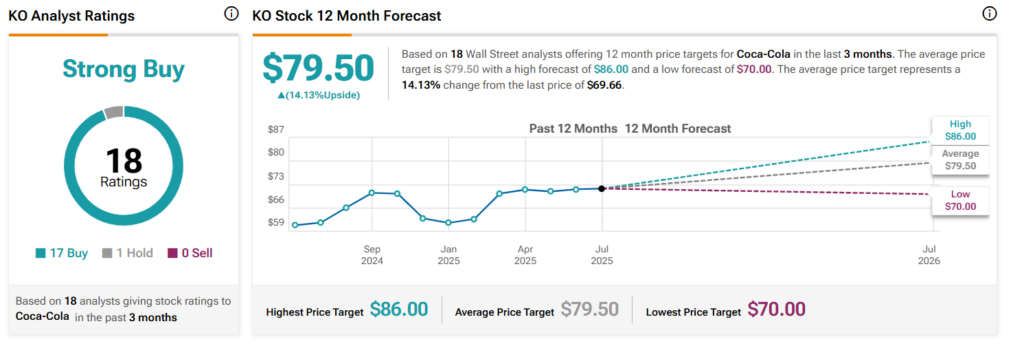Coca-Cola (NYSE: KO), one of Warren Buffett’s long-standing investments, holds a bullish rating from Wall Street, with analysts anticipating further upside for the beverage giant.
According to TipRanks, 18 analysts have rated KO stock a ‘Strong Buy,’ with 17 assigning a ‘Buy’ rating and only one opting for a ‘Hold.’ Notably, there are no ‘Sell’ ratings.
The bullish sentiment is backed by an average 12-month price target of $79.50, implying a 14.13% upside from Coca-Cola’s current price of $69.66. Analyst forecasts range from a low of $70 to a high of $86.

Investor confidence is underpinned by Coca-Cola’s solid fundamentals and its 64-year streak of dividend hikes. The next dividend of $0.51 per share, payable on October 1, will yield $204 million for Berkshire Hathaway (NYSE: BRK.A), based on its 400 million shares, currently valued at $27.9 billion.
KO stock fundamentals
Beyond its dividend appeal and backing from investors like Buffett, Coca-Cola presents a compelling buying case. Its iconic brand portfolio enjoys strong consumer loyalty, making it resilient even in challenging market conditions.
The company’s outsourced production model also minimizes exposure to tariffs, enhancing operational stability. With shares still trading below the consensus target of $79.50, investors may view this as a favorable entry point.
Meanwhile, Coca-Cola continues to report strong financials. In Q2 2025, the company exceeded earnings expectations, reporting an EPS of $0.87, which surpassed the projected $0.83. This upside was driven by stronger-than-expected gross margins, which rose to 62.4%.
Although revenue slightly missed at $12.5 billion (versus the expected $12.55 billion), a 5% growth in organic revenue helped offset a 1% decline in unit case volume.
Following the strong Q2 results, Deutsche Bank raised its price target on Coca-Cola to $81 from $80, while maintaining a ‘Buy’ rating. The firm expressed confidence in the company’s second-half outlook, citing anticipated growth in unit case sales, ongoing productivity gains, and reinvestment efforts.
Featured image via Shutterstock







